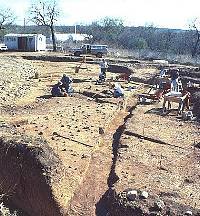
View south of the Pavo Real excavations during the
fall of 1979. The surface upon which the archeologists
are sitting and standing is very near the original
ground surface about 13,000 years ago. looking northwest
Click on any small
image for an enlarged view.
|

View of site area as it appeared
during the 1979 excavations. At the time, only a single
two-lane bridge crossed Leon creek. As can be seen,
across the creek from the archeological site is a tall
limestone bluff. Seams of chert (flint) that are still
exposed in the bluff are part of an outcrop of Edwards
Chert which drew the attention of passing hunting and
gathering groups for thousands of years. The creek itself
provided water and nourished plants and animals that,
in turn, nourished the prehistoric peoples who camped
here.
|
|
FAQ: What are
the Archaic and Paleoindian periods?
These broad periods were conceived
of as "stages" of cultural development ....
read
more>>
|
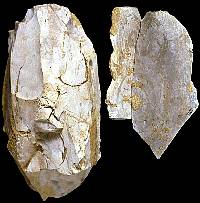
Clovis blade core and two blades
(removed from a different core) from Pavo Real. The
site was one of the first places in North America where
abundant evidence of Clovis blade technology was found.
This technology allowed Clovis flint knappers to efficiently
reduce nodules and small boulders of chert/flint into
parallel-sided blades that could be turned into various
kinds of tools.
|

Site area after construction of the
first phase of the expanded highway.
|
|
Every day over 160,000 vehicles drive over Leon
Creek on Loop 1604 just west of Interstate 10 in northwest
San Antonio, Texas. As they speed over the creek, few drivers
have any idea that Clovis and Folsom peoples once camped here
some 12,000-13,000 years ago. Of course, long ago ancient
campsites were common along the spring-fed streams that drain
the Edwards Plateau along the Balcones Escarpment and some
are still preserved today, despite the intense urban and suburban
development in this area of Texas. But this particular place,
which is known today as the Pavo Real site, was the subject
of a major archeological excavation in 1979-1980. This is
its story.
In the late 1970s the Texas Department of Transportation
(TxDOT, then called the Texas Department of Highways and Public
Transportation) was in the process of expanding a rural two-lane
road, FM 1604, into a divided, multiple-lane suburban highway
(Loop 1604) in northern Bexar County. In the highway's path
lay a known archeological site with the official designation
41BX52 (being the 52nd site recorded in Bexar County,
Texas). The archeological site was situated on the banks of
Leon Creek on the inside of a bend in the stream. In 1979
the potential significance of the site was brought to the
attention of TxDOT archeologists, who soon began archeological
excavations there in an attempt to mitigate the looming impact
of the highway construction project.
The excavations revealed a rather typical Archaic-era
accumulation of burned rocks (spent cooking stones) and tool-making
debris first seen on the surface and found buried within the
shallow soils that had built up along a low stream terrace
that extended for several hundred yards along Leon Creek.
Artifacts and cooking pits (hearths) showed that Archaic hunters
and gatherers had camped briefly at this spot off and on for
at least 7,000 years. Below the Archaic deposits was a series
of stream-laid gravel, sand, and silt layers that accumulated
near the end of the Pleistocene (last Ice Age) about 10,000-11,00
B.C. As the end of the planned dig neared in August, 1979,
the excavators started finding early Paleoindian artifacts
including Folsom and Clovis points in a thin layer sandwiched
between layers of gravel.
At the time, few Early Paleoindian sites had
ever been investigated in this area of Texas and the site
on Leon Creek appeared to hold great promise for understanding
lives of the mobile "big game hunters," as Clovis
and Folsom peoples were thought to represent. So the dig was
extended and allowed to continue even as construction on the
new highway continued apace all around the excavation. Abundant
evidence of stone tool-making activities dating mainly to
the Clovis period (about 13,500 to 12,500 years ago or 10,500-11,500
B.C.) was found. Clovis "knappers" (short for flint-knappers,
the term for those who make tools by chipping or knapping
flint or "chert") had taken advantage of the abundant
chert that outcrops just across Leon Creek from the campsite.
They had knocked off large, narrow "blades" from
chert nodules and fashioned various kinds of cutting and scraping
tools from them.
After several more months of digging, the excavations
were halted and a new bridge was built over Leon Creek, entombing
in concrete what remained of the archeological site, which
had been named Pavo Real (Spanish for peacock). The archeological
excavations at the Pavo Real site had recovered important
evidence of early Paleoindian lifeways as well as some new
insight into the Archaic period as well. Unfortunately,
the original excavators were not able to publish a report
on their work. The Pavo Real materials remained unanalyzed
for 20 years. As a result the important discoveries made at
the site lost much of their impact as comparable discoveries
were made elsewhere in Texas and elsewhere in North America.
Two decades later, TxDOT contracted with the
Texas Archeological Research Laboratory of the University
of Texas at Austin to complete the analysis and reporting
of the Pavo Real site. An extensive technical report was prepared
that provides a detailed scientific appraisal of the archeological
site. The web exhibit you are reading is a public education
outreach effort intended to summarize and illustrate the most
important findings.
There are four additional parts of this exhibit.
Site and Its
Investigation: a description of the ecological and geological
setting of Pavo Real and a more detailed summary of the archeological
investigations, both the original field work and the recent
analysis.
Archaic
Pavo Real: summary of what has been leaned about the Archaic
period occupations at the site.
Paleoindian
Pavo Real: summary of what has been learned about the
early Paleoindian period occupations at the site.
Credits
& Sources: acknowledgements and sources for more information.
|
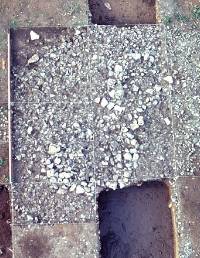
Overhead photograph of the center
of an Archaic-period burned rock midden. The two partially
intersecting rings of larger rocks are remnants of the
heating elements of large earth ovens. Hunters and gatherers
probably baked roots in layered arrangements called
earth ovens because they were originally capped by thick
layers of earth that held in the heat. Burned rock middens
are the result of many episodes of earth-oven cooking.
|
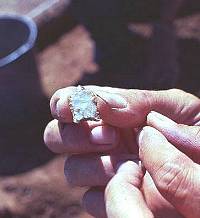
Archeologist holds miniature Paleoindian
projectile point found at the Pavo Real site. It is
not known whether this artifact was made by Clovis or
Folsom people.
|
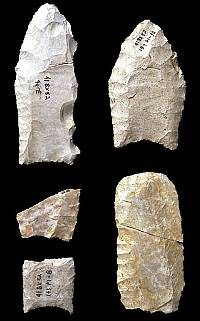
Early Paleoindian artifacts from
Pavo Real. Two Clovis points at the top, two fragments
of Folsom points in the lower left and a blade tool
(lower right).
|
|






